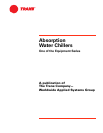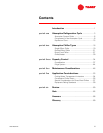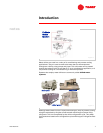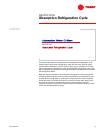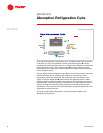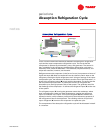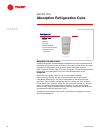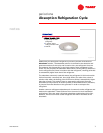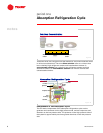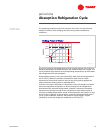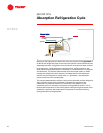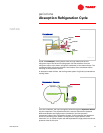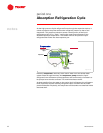
TRG-TRC011-EN 5
period one
Absorption Refrigeration Cycle
notes
There are two fundamental differences between the absorption refrigeration
cycle and the vapor-compression refrigeration cycle. The first is that the
compressor is replaced by an absorber, pump, and generator. The second is
that, in addition to the refrigerant, the absorption refrigeration cycle uses a
secondary fluid, called the absorbent. The condenser, expansion device, and
evaporator sections, however, are the same.
Refrigerant enters the evaporator in the form of a cool, low-pressure mixture of
liquid and vapor ($). Heat is transferred from the relatively warm water to the
refrigerant, causing the liquid refrigerant to boil. Using an analogy of the vapor-
compression cycle, the absorber acts like the suction side of the compressor—it
draws in the refrigerant vapor (%) to mix with the absorbent. The pump acts like
the compression process itself—it pushes the mixture of refrigerant and
absorbent up to the high-pressure side of the system. The generator acts like
the discharge of the compressor—it delivers the refrigerant vapor (&) to the rest
of the system.
The refrigerant vapor (&) leaving the generator enters the condenser, where
heat is transferred to water at a lower temperature, causing the refrigerant
vapor to condense into a liquid. This liquid refrigerant (') then flows to the
expansion device, which creates a pressure drop that reduces the pressure of
the refrigerant to that of the evaporator. The resulting mixture of liquid and
vapor refrigerant ($) travels to the evaporator to repeat the cycle.
The components of the absorption refrigeration cycle will be discussed in detail
in a moment.
pump
pump
expansion
expansion
device
device
absorb heat
absorb heat
reject heat
reject heat
heat energy in
heat energy in
reject heat
reject heat
evaporator
evaporator
condenser
condenser
absorber
absorber
generator
generator
$
%
&
'
Figure 6



